The Non-Invasive Respiratory Monitoring Market is estimated to be valued at USD 9.4 billion in 2025 and is projected to reach USD 16.9 billion by 2035, registering a compound annual growth rate (CAGR) of 6.0% over the forecast period.
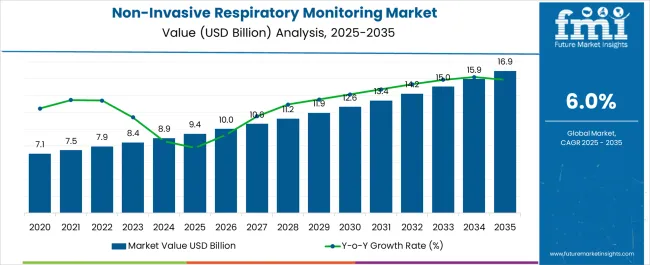
| Metric | Value |
|---|---|
| Non-Invasive Respiratory Monitoring Market Estimated Value in (2025 E) | USD 9.4 billion |
| Non-Invasive Respiratory Monitoring Market Forecast Value in (2035 F) | USD 16.9 billion |
| Forecast CAGR (2025 to 2035) | 6.0% |
The non invasive respiratory monitoring market is experiencing strong momentum driven by the rising global burden of respiratory diseases, increasing awareness of early diagnosis, and advancements in portable and digital monitoring devices. The demand for non invasive methods has intensified due to patient preference for comfort, real time monitoring capabilities, and reduced risk of complications compared to invasive techniques.
Integration of wireless technologies and AI based analytics has enhanced accuracy, enabled remote monitoring, and facilitated telehealth adoption across healthcare systems. Hospitals and clinics are investing in modern respiratory monitoring solutions to improve patient outcomes, reduce readmission rates, and manage chronic conditions effectively.
Regulatory support and reimbursement frameworks in key markets are further promoting adoption. The outlook remains promising as innovations in compact and user friendly devices continue to expand accessibility across both developed and emerging healthcare landscapes.

The spirometer segment is projected to account for 47.20% of total market revenue by 2025 within the product category, making it the leading product type. Its dominance is supported by its critical role in diagnosing and monitoring asthma, chronic obstructive pulmonary disease, and other respiratory conditions.
The device’s ease of use, non invasive nature, and ability to provide rapid lung function assessment have strengthened its clinical relevance. Additionally, advancements in digital spirometers with wireless connectivity and real time data integration have improved diagnostic accuracy and patient compliance.
Growing awareness of preventive respiratory healthcare and the need for effective disease management strategies are also reinforcing the uptake of spirometers, consolidating their position as the most widely adopted product in the market.
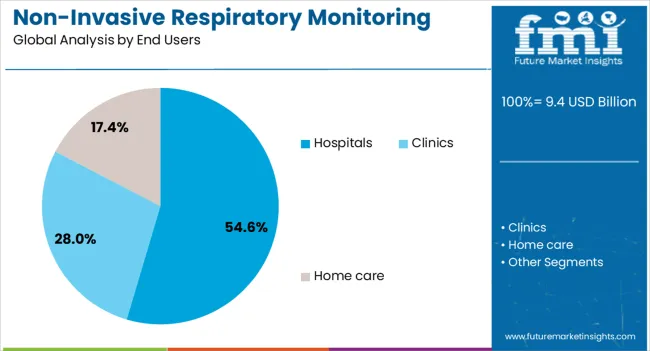
The hospitals segment is expected to contribute 54.60% of total market revenue by 2025 under the end user category, securing its position as the dominant segment. Hospitals continue to be the primary centers for diagnosis, treatment, and long term monitoring of respiratory conditions, driving higher demand for advanced respiratory monitoring systems.
Their capacity to integrate technologically advanced devices, maintain trained medical staff, and manage large patient volumes has further contributed to this leadership. Moreover, hospitals benefit from favorable reimbursement policies and are often the first to adopt new innovations in respiratory monitoring.
The increasing prevalence of chronic respiratory illnesses, coupled with a rise in hospital admissions due to acute respiratory conditions, has reinforced reliance on these facilities. As a result, hospitals remain the cornerstone of adoption, ensuring comprehensive care through non invasive respiratory monitoring solutions.
According to the latest research by Future Market Insight, The Non-Invasive Respiratory Monitoring market is set to witness Soaring growth in the forecast period 2025 to 2035 at a CAGR of 8%. The respiratory monitoring device has a wide range of applications in all diseases related to respiration.
In the developing world, the air is getting polluted at a high rate due to this many breathing problems occur to citizens worldwide. In fact, respiratory diseases are listed as the world’s biggest health concern, causing one-sixth of all deaths globally. These reasons signify the soaring growth of the market in the forecast period globally.
The growing rate of respiratory disease globally due to the developments going on worldwide drives the market demand in the coming period. Factors such as highly accurate, rapid, and effective results produced by the Respiratory monitoring devices fuel the growth of the market.
The Increasing prevalence of asthma and chronic obstructive pulmonary diseases (COPDs) are some of the major factors driving the demand for respiratory monitoring devices.
The Covid-19 pandemic became the major factor responsible for the bullish growth in the market. Increasing efforts to introduce new technologies, sensors which are capable of providing accurate measurement on respiration rate.
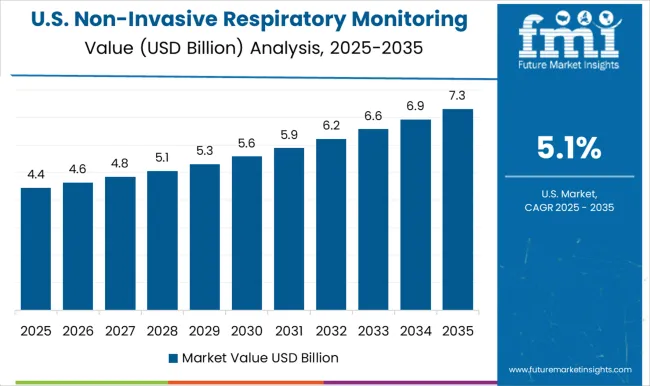
North American region holds the largest share in the respiratory monitoring devices.
The factor responsible for the large share in segment are, the high awareness about Oximeters, spirometers and plethysmographs, economic capability to purchase expensive machines in large number, prevalence of respiratory diseases, rising demand for technologically advanced and innovative products in hospitals, diagnostic laboratories, home care , and outpatient ambulatory surgery centers and presence of well established companies in the region.
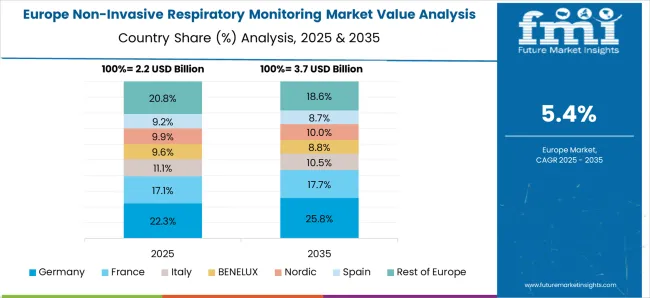
Europe holds the second largest share in the market, the factors responsible for the same are, the Highest Covid-19 cases which LED in the highest demand of the respiratory monitoring market, The presence of established companies and developing companies boosts the demand of market.
Asia pacific is predicted to be the fastest developing region as the heath care expenditure is increasing year on year, the population is increasing, number of emerging companies is increasing every year, the introduction of new technologies boosts the demand of the market.
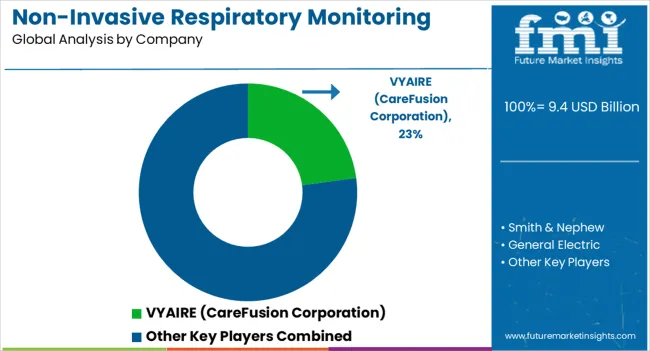
According to FMI Analysis,
are identified as the key players of the Non-invasive respiratory monitoring market.
Masimo Corporation introduces Root Patient monitoring and connectivity platform in September 2024.
The report is a compilation of first-hand information, qualitative and quantitative assessment by industry analysts, inputs from industry experts and industry participants across the value chain. The report provides in-depth analysis of parent market trends, macro-economic indicators and governing factors along with market attractiveness as per segments.
The report also maps the qualitative impact of various market factors on market segments and geographies.
The global non-invasive respiratory monitoring market is estimated to be valued at USD 9.4 billion in 2025.
The market size for the non-invasive respiratory monitoring market is projected to reach USD 16.9 billion by 2035.
The non-invasive respiratory monitoring market is expected to grow at a 6.0% CAGR between 2025 and 2035.
The key product types in non-invasive respiratory monitoring market are spirometer, pulse oximeter, peak flow meter and capnographs.
In terms of end users, hospitals segment to command 54.6% share in the non-invasive respiratory monitoring market in 2025.






Full Research Suite comprises of:
Market outlook & trends analysis
Interviews & case studies
Strategic recommendations
Vendor profiles & capabilities analysis
5-year forecasts
8 regions and 60+ country-level data splits
Market segment data splits
12 months of continuous data updates
DELIVERED AS:
PDF EXCEL ONLINE
Non-Invasive Blood Glucose Monitoring Devices Market Size and Share Forecast Outlook 2025 to 2035
Respiratory Trainer Market Size and Share Forecast Outlook 2025 to 2035
Respiratory Distress Syndrome Management Market Size and Share Forecast Outlook 2025 to 2035
Respiratory Analysers Market Size and Share Forecast Outlook 2025 to 2035
Respiratory Protective Equipment Market Size and Share Forecast Outlook 2025 to 2035
Respiratory Measurement Devices Market Size and Share Forecast Outlook 2025 to 2035
Respiratory Heaters Market Trends and Forecast 2025 to 2035
Respiratory Pathogen Testing Kits Market Insights - Growth & Forecast 2025 to 2035
Respiratory Inhaler Devices Market Report – Size & Forecast 2025-2035
Understanding Market Share Trends in Respiratory Inhaler Devices
Respiratory Gating Market Analysis – Size, Share & Forecast 2025-2035
Respiratory Device Market Insights – Growth & Forecast 2024-2034
Global Respiratory Biologics Market Analysis – Size, Share & Forecast 2024-2034
Home Respiratory Therapy Market – Growth & Forecast 2025 to 2035
Japan Respiratory Inhaler Devices Market Size and Share Forecast Outlook 2025 to 2035
Swine Respiratory Diseases Treatment Market Analysis - Size and Share Forecast Outlook 2025 to 2035
Human RSV Treatment Market Insights - Innovations & Forecast 2025 to 2035
Upper Respiratory Tract Infection Treatment Market
Germany Respiratory Inhaler Devices Market Insights – Demand, Trends & Outlook 2025-2035
Chronic Respiratory Diseases Treatment Market

Thank you!
You will receive an email from our Business Development Manager. Please be sure to check your SPAM/JUNK folder too.
Chat With
MaRIA